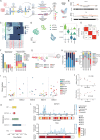This is a preprint.
Genotype-to-phenotype mapping of somatic clonal mosaicism via single-cell co-capture of DNA mutations and mRNA transcripts
- PMID: 38826366
- PMCID: PMC11142212
- DOI: 10.1101/2024.05.22.595241
Genotype-to-phenotype mapping of somatic clonal mosaicism via single-cell co-capture of DNA mutations and mRNA transcripts
Abstract
Somatic mosaicism is a hallmark of malignancy that is also pervasively observed in human physiological aging, with clonal expansions of cells harboring mutations in recurrently mutated driver genes. Bulk sequencing of tissue microdissection captures mutation frequencies, but cannot distinguish which mutations co-occur in the same clones to reconstruct clonal architectures, nor phenotypically profile clonal populations to delineate how driver mutations impact cellular behavior. To address these challenges, we developed single-cell Genotype-to-Phenotype sequencing (scG2P) for high-throughput, highly-multiplexed, single-cell joint capture of recurrently mutated genomic regions and mRNA phenotypic markers in cells or nuclei isolated from solid tissues. We applied scG2P to aged esophagus samples from five individuals with high alcohol and tobacco exposure and observed a clonal landscape dominated by a large number of clones with a single driver event, but only rare clones with two driver mutations. NOTCH1 mutants dominate the clonal landscape and are linked to stunted epithelial differentiation, while TP53 mutants and double-driver mutants promote clonal expansion through both differentiation biases and increased cell cycling. Thus, joint single-cell highly multiplexed capture of somatic mutations and mRNA transcripts enables high resolution reconstruction of clonal architecture and associated phenotypes in solid tissue somatic mosaicism.
Conflict of interest statement
Competing Interests D.A.L. serves on the Scientific Advisory Board of Mission Bio, Pangea, Alethiomics, Montage and Veracyte. D.A.L. has received prior research funding from 10x Genomics, Illumina, and Ultima Genomics unrelated to the current manuscript. D.D. and S.W. are employees of Mission Bio. D.D. is listed as an inventor on a granted patent (US patent 11365441) and a submitted patent (US patent application 16/839,057). S.W. is listed as an inventor on a submitted patent (US patent application 16/936,378) No other authors report competing interests.
Figures


References
-
- Martincorena I. & Campbell P. J. Somatic mutation in cancer and normal cells. Science 349, 1483–1489 (2015). - PubMed
Publication types
Grants and funding
LinkOut - more resources
Full Text Sources
Research Materials
Miscellaneous
